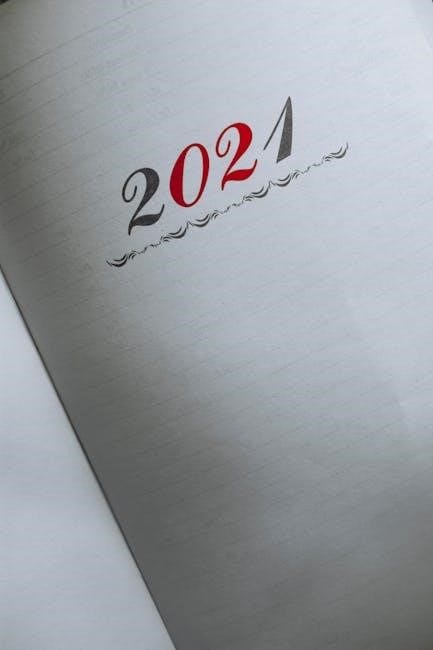Informational writing graphic organizers are visual tools designed to help writers brainstorm, organize, and structure their ideas effectively. They provide templates for planning and outlining content, making the writing process clearer and more focused. These organizers are particularly useful for students and educators, offering a framework to develop topic sentences, supporting details, and concluding statements. With free PDF templates available online, they are accessible and customizable to meet specific writing needs, fostering better organization and clarity in informational writing tasks.
1.1 Definition and Purpose
Informational writing graphic organizers are structured templates designed to help writers plan and organize content effectively. They provide sections for topic sentences, supporting details, and evidence, guiding the development of clear and logical writing. Their purpose is to assist in creating well-organized summaries, essays, or reports, ensuring ideas are presented coherently. These tools are especially useful for students, offering a clear framework to enhance writing clarity and structure.
1.2 Importance in Educational Settings
Graphic organizers are invaluable in educational settings as they enhance students’ ability to organize and present information clearly. They help students develop critical thinking skills by visually structuring ideas, making complex concepts more manageable. These tools also support diverse learners, providing a clear framework for writing tasks and fostering academic success. Educators widely use them to teach effective writing strategies and improve overall learning outcomes in the classroom.

Benefits of Using Graphic Organizers for Informational Writing
Graphic organizers enhance writing structure, promote critical thinking, and facilitate idea generation. They help students organize information logically, making writing more coherent and focused, while supporting diverse learning needs.
2.1 Improved Structure and Organization
Graphic organizers provide a clear framework for arranging ideas, ensuring essays are logically structured. They help students outline main ideas, supporting details, and evidence, fostering a coherent and focused narrative. By visually separating components, organizers prevent tangents and improve flow, making the writing process more systematic and manageable for learners of all levels.
2.2 Enhanced Critical Thinking and Idea Generation
Graphic organizers stimulate critical thinking by prompting students to analyze information, identify relationships, and explore multiple perspectives. They encourage the generation of ideas by visually mapping concepts, making abstract thoughts more concrete. This structured approach fosters deeper understanding and helps students develop well-supported arguments, enhancing the overall quality of their informational writing.
2.3 Support for Diverse Learners
Graphic organizers are invaluable for diverse learners, offering visual and structured frameworks that cater to various learning styles. They help students with special needs, English language learners, and visual learners by breaking down complex information into manageable parts. This adaptability ensures all students can engage effectively with content, fostering inclusivity and improved academic performance.
Key Components of an Informational Writing Graphic Organizer
An effective graphic organizer includes a topic sentence, supporting details, evidence, and a concluding sentence. These elements provide clarity and structure, guiding writers to produce coherent content.
3.1 Topic Sentence
A topic sentence is the main idea of a paragraph, clearly stating the central concept. In a graphic organizer, it is placed at the top or in a dedicated section to guide the writer. A strong topic sentence ensures focus and clarity, helping to structure the content effectively. It sets the purpose for the paragraph, making it easier to organize supporting details and evidence.
3.2 Supporting Details and Evidence
Supporting details and evidence are essential for reinforcing the topic sentence. Graphic organizers provide dedicated sections for listing facts, examples, and explanations that validate the main idea. These details help build credibility and depth, ensuring the content is thorough and persuasive. By organizing evidence clearly, writers can effectively support their claims and make their arguments more convincing. This step strengthens the overall structure of the writing.
3.3 Concluding Sentence
The concluding sentence effectively wraps up the paragraph by summarizing key points or restating the topic sentence. Graphic organizers often include a section for crafting this sentence, ensuring it ties back to the introduction and reinforces the main idea. A strong conclusion leaves a lasting impression, solidifying the writer’s message and providing closure to the reader. This structured approach enhances clarity and coherence in informational writing.

How to Choose the Right Graphic Organizer
Selecting the right graphic organizer involves aligning it with learning objectives and the specific writing task. Consider design, functionality, and how well it meets student needs and preferences.
4.1 Identifying Learning Objectives
Identifying learning objectives is crucial for selecting the right graphic organizer. Determine if the goal is to compare ideas, organize hierarchically, or sequence events. Align the organizer with curriculum standards and desired outcomes. For informational writing, focus on tools that enhance clarity, structure, and evidence-based reasoning. Ensure the organizer matches the complexity and depth required by the task for optimal student engagement and understanding. Use free PDF templates to simplify implementation and customization.
4.2 Matching the Organizer to the Writing Task
Match the graphic organizer to the writing task by considering the type of informational writing. Use Venn diagrams for comparisons, tree maps for hierarchical structures, or flowcharts for sequential tasks. Ensure the organizer aligns with the task’s requirements, such as comparing, explaining, or sequencing. Free PDF templates offer versatile designs to suit different writing objectives, enhancing clarity and coherence in student work.

Popular Types of Graphic Organizers for Informational Writing
Popular graphic organizers include Venn diagrams for comparisons, tree maps for hierarchical ideas, and flowcharts for sequences. These tools enhance structure and clarity in writing tasks.
5.1 Venn Diagrams for Comparing and Contrasting
Venn diagrams are circular charts with overlapping sections, ideal for comparing and contrasting ideas. They help writers visualize similarities and differences, making complex relationships clear. Students can place shared traits in the overlap and unique aspects in separate circles. This tool fosters analytical thinking and provides a structured way to organize comparisons, enhancing clarity in informational writing tasks.
5.2 Tree Maps for Hierarchical Organization
Tree maps are hierarchical diagrams that use branches to organize information. They start with a main idea and expand into subtopics and details. This structure helps writers break down complex topics into manageable sections. Tree maps are excellent for outlining essays or articles. They can be downloaded as free PDF templates and customized to suit various writing projects. Using tree maps enhances organization and clarity in informational writing, aiding in effective planning and structuring of content.
5.3 Flowcharts for Sequential Writing
Flowcharts are visual tools that guide writers through sequential processes. They are ideal for outlining events, procedures, or cause-effect relationships. Free PDF templates of flowcharts can be downloaded and adapted for informational writing tasks. They help create logical flow, ensure coherence, and clarify steps in a process. Flowcharts are particularly useful for narrative or explanatory writing, making complex sequences easy to follow and organize. They enhance the structure and readability of content, making them a valuable resource for educators and students alike. Flowcharts can also be customized to suit specific writing projects, offering flexibility and versatility in their application.

How to Use a Graphic Organizer for Informational Writing
Start by brainstorming ideas, then organize them into categories. Use free PDF templates to structure content visually, ensuring clarity and coherence in the writing process.
6.1 Brainstorming Ideas
Begin by downloading a free informational writing graphic organizer PDF to guide brainstorming. Start with a central topic, then branch out to related subtopics and supporting details. Use the organizer’s visual structure to connect ideas logically, ensuring a clear flow of information. This step helps writers generate and organize thoughts effectively, saving time and reducing overwhelm.
6.2 Organizing Ideas into Categories
After brainstorming, use the graphic organizer to categorize ideas into main topics and subtopics. Group related details together under each category, ensuring a logical flow. This step helps writers visualize connections and prioritize information. The structured format of the PDF template makes it easier to transform ideas into a coherent outline, ready for drafting the final informational text.
6.3 Revising and Refining Content
After organizing ideas, review the graphic organizer to refine and clarify content. Ensure each category aligns with the writing goal and supports the main topic. Revise vague or redundant details, strengthening connections between ideas. Use the PDF template to rephrase or restructure sections for better flow and coherence, ensuring the final draft is polished and well-organized before writing begins.

The Role of Mentor Texts in Informational Writing
Mentor texts provide exemplary models of informational writing, helping students analyze structure, tone, and techniques. They guide the use of graphic organizers by illustrating how ideas are effectively organized and presented, making them invaluable for teaching writing skills in the classroom.
7.1 Highlighting Key Information
Mentor texts excel at showcasing main ideas, supporting details, and evidence, which aligns perfectly with the structure of graphic organizers. By analyzing these texts, students learn to identify and extract key information, a crucial skill for informational writing. This alignment helps students understand how to organize their own writing effectively, ensuring clarity and coherence in their work.
7.2 Applying Mentor Text Strategies to Graphic Organizers
Mentor texts provide clear examples of effective writing structures and techniques. By analyzing these texts, educators can guide students in transferring key strategies to graphic organizers. For instance, identifying main ideas and supporting details in mentor texts helps students organize their own ideas more coherently. This approach bridges the gap between reading and writing, enhancing the overall quality of student work while utilizing free PDF templates for structured planning.

Graphic Organizers for Expository Essays
Graphic organizers help students structure expository essays clearly, enhancing writing skills and content organization. Free PDF templates provide accessible tools for effective planning and execution.
8.1 Structure of an Expository Essay
An expository essay typically follows a clear structure, starting with a thesis statement, followed by main ideas supported by evidence, and concluding with a summary. Graphic organizers help students plan this structure by visually mapping the introduction, body paragraphs, and conclusion, ensuring logical flow and coherence. Free PDF templates provide pre-designed layouts to guide this process effectively for both teachers and students.
8.2 Examples of Graphic Organizers for Expository Writing
Popular graphic organizers for expository writing include the Expository Essay Planner, Cause-and-Effect Diagrams, and Compare/Contrast Charts. These tools help students outline their essays, organize evidence, and visualize relationships between ideas. Free PDF templates like the Expository Writing Web and Five-Paragraph Essay Map are widely available online, offering structured frameworks for clear and concise writing. They cater to various learning styles and writing tasks.
Digital Tools for Creating Graphic Organizers
Digital tools like Google Docs and Canva offer free templates and design features to create customizable graphic organizers for informational writing, supporting various learning needs effectively.
9.1 Google Docs Templates
Google Docs provides a variety of free templates for creating graphic organizers tailored to informational writing. Users can access pre-designed layouts for concepts like Venn diagrams and tree maps, easily customizable to suit specific topics. These templates support collaborative editing and can be downloaded as PDFs for offline use, making them a versatile tool for both teachers and students.
9;2 Canva and Other Design Tools
Canva and similar design tools offer user-friendly interfaces for creating graphic organizers. They provide customizable templates with drag-and-drop features, enabling users to design visually appealing layouts. These tools are ideal for informational writing, allowing educators and students to craft tailored organizers. Many templates are free, and designs can be exported as PDFs for easy sharing and printing, enhancing classroom collaboration and creativity.
Free PDF Templates for Informational Writing
Free PDF templates simplify the creation of graphic organizers for informational writing. Easily downloadable, these templates offer pre-designed structures, saving time and ensuring consistency. They cater to various writing tasks, making them invaluable for teachers and students seeking quick, accessible resources to enhance learning and organization.
10.1 Sources for Downloading Free PDFs
Teachers and students can find free PDF templates for informational writing graphic organizers on platforms like Teachers Pay Teachers, Google Drive, and Pinterest. These websites offer a variety of downloadable templates designed for different writing tasks. Many templates are created by educators and are easily accessible, saving time and effort. They are often customizable to suit specific learning needs and are frequently updated with new designs.
10.2 Customizing Templates for Specific Needs
Customizing graphic organizer templates allows educators to tailor them to specific writing tasks or student needs. Users can modify sections, add prompts, or adjust layouts using tools like Adobe Acrobat or online PDF editors. This ensures the organizer aligns with curriculum goals and supports diverse learning styles, making it more effective for teaching and learning outcomes.
Implementing Graphic Organizers in the Classroom
Implementing graphic organizers involves introducing them to students, modeling their use, and integrating them into daily writing routines to enhance learning outcomes and engagement for both educators and students.
11.1 Lesson Planning and Integration
Effective lesson planning involves incorporating graphic organizers to align with learning objectives and standards. Teachers can integrate these tools into writing units, using free PDF templates to guide students through brainstorming and organizing ideas. By embedding organizers into daily routines, educators create structured pathways for students to develop coherent and well-supported informational writing skills, fostering engagement and understanding across diverse learning needs.
11.2 Classroom Activities to Support Organizer Use
Engaging classroom activities include guided brainstorming sessions using graphic organizers, collaborative group work to fill out templates, and independent writing exercises. Teachers can incorporate pair-share activities, gallery walks, and peer reviews to reinforce understanding. These practices encourage active participation and help students effectively apply graphic organizers to structure their informational writing, fostering clarity and coherence in their work.

Tips for Effective Use of Graphic Organizers
Start with simple templates, encourage customization, and integrate organizers into daily lessons. Focus on main ideas and supporting details, and allow peer discussions to enhance understanding and application.
12.1 Best Practices for Teachers
Introduce graphic organizers gradually, aligning them with lesson goals. Use mentor texts to model their purpose. Encourage customization to fit individual needs. Provide clear instructions and examples. Allow time for peer collaboration to enhance understanding. Regularly review and offer constructive feedback. Integrate organizers across subjects to reinforce skills. Make them accessible digitally for flexibility and easy sharing.
12.2 Common Mistakes to Avoid
Common mistakes include overcomplicating graphic organizers, making them too detailed, and not aligning them with specific writing tasks. Providing insufficient examples or guidance can confuse students. Neglecting to review and adjust organizers based on feedback is another error. Overloading them with excessive information can hinder clarity. Ensure flexibility and simplicity, allowing students to adapt organizers to their needs for effective learning and proper differentiation.

Case Studies and Success Stories
Case studies highlight how free PDF graphic organizers boost student engagement and improve writing clarity. Teachers find these tools versatile and easy to integrate into curricula.
13.1 Educator Insights and Experiences
Educators often praise the effectiveness of free PDF graphic organizers for informational writing, noting improved structure and clarity in student work. Many report that these tools enhance engagement and foster deeper understanding. Teachers appreciate the versatility of downloadable templates, which can be tailored to various learning levels and subjects. For example, organizers have been successfully used in history classes to outline timelines and in science for explaining processes. The user-friendly nature of PDFs makes them accessible for both digital and print use, supporting diverse classroom needs. Overall, educators highlight the positive impact of these resources on teaching and learning outcomes.
13.2 Student Feedback and Outcomes
Students consistently report that free PDF graphic organizers improve their understanding of informational writing. Many find the structured format helps them organize ideas more effectively. Feedback highlights increased confidence in writing, as the visual layout makes complex tasks feel manageable. Improved grades and enhanced clarity in assignments are frequently noted outcomes. Engagement levels also rise, with students appreciating the interactive approach to learning.

The Future of Graphic Organizers in Education
The future of graphic organizers in education lies in interactive, adaptable digital tools that enhance learning. Free PDFs will evolve to include more dynamic, customizable features, making them indispensable for teachers and students alike.
14.1 Emerging Trends in Educational Technology
Emerging trends in educational technology are transforming graphic organizers, with AI-driven tools and interactive platforms enhancing their functionality. Gamification, real-time collaboration, and cloud-based solutions are becoming integral, allowing students to create and share digital organizers effortlessly. Free PDF templates are evolving into dynamic, multimedia-rich resources, ensuring accessibility and engagement for diverse learners. Tools like Google Docs and Canva are leading this innovative charge.
14.2 Innovations in Graphic Organizer Design
Innovations in graphic organizer design focus on enhancing user experience and adaptability. Modern templates now include interactive elements, such as drag-and-drop features and customizable fields, making them more engaging. Adaptive designs cater to different learning styles, with visuals and multimedia integration. These innovations ensure graphic organizers remain versatile tools for both traditional and digital classrooms, supporting diverse learning needs effectively.
15.1 Summary of Key Points
Graphic organizers are powerful tools that enhance informational writing by improving structure, fostering critical thinking, and supporting diverse learners. Free PDF templates offer convenient, cost-effective solutions for educators, providing structured frameworks to guide students in organizing ideas, conducting research, and producing coherent, well-structured essays. These resources are invaluable for teaching effective writing strategies across various educational settings.
15.2 Final Thoughts on the Value of Graphic Organizers
Graphic organizers are indispensable tools for enhancing informational writing, offering structured frameworks to clarify ideas and improve coherence. Free PDF templates provide accessible resources for educators, enabling students to develop critical thinking and organizational skills. Their versatility supports diverse learning needs, making them a valuable asset for fostering academic success and lifelong writing proficiency.
